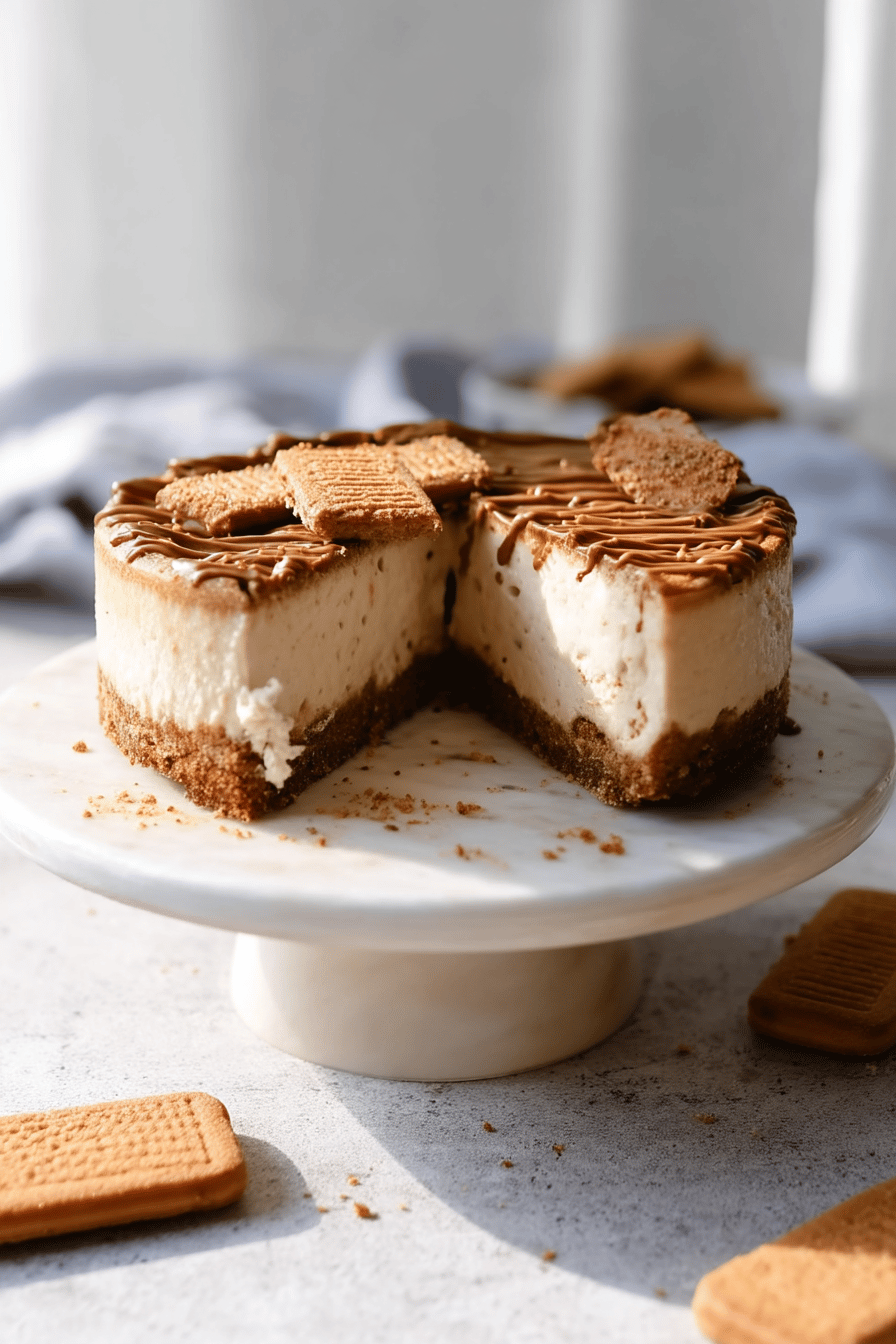Benefits and Advantages of Biscoff Cheesecake
The biscoff cheesecake recipe stands out due to its simple preparation process, making it accessible for both novice and experienced bakers. With minimal baking skills required, this dessert delivers a rich and indulgent treat perfect for any occasion, from casual gatherings to festive celebrations. The unique flavor profile of biscoff cookies adds delightful caramelized and spiced notes that harmonize beautifully with the creamy texture of the cheesecake, offering a truly satisfying experience.
Health-conscious individuals will appreciate that the recipe can be adapted into vegan and gluten-free versions without sacrificing taste, allowing a broader range of dietary preferences to enjoy it. The recipe’s wholesome ingredients provide a balanced dessert that’s simultaneously indulgent yet mindful of nutritional content.
Versatility is another key advantage; you can easily tailor the cheesecake to specific tastes or dietary needs, making it an ideal go-to recipe. Its quick preparation and high-quality results make the biscoff cheesecake both practical and crowd-pleasing, perfect for home cooks who want an impressive dessert without a complicated process.
Essential Ingredients for Biscoff Cheesecake
- 250 grams Biscoff cookies (about 1 package or 200 grams in some variations)
- 75 grams unsalted butter (or vegan butter, melted; some recipes use 80 grams)
- 907 grams cream cheese, softened (approximately 4 packages of 8 oz each) or around 400 grams for smaller versions
- 1 cup (200 grams) brown sugar
- 1/4 cup (50 grams) granulated sugar
- 1/2 cup (120 grams) sour cream (can substitute with Greek yogurt or blended cottage cheese)
- 1 cup (240 grams) Biscoff cookie butter/spread
- 1 tablespoon vanilla extract
- 1/4 teaspoon salt
- 4 large eggs, room temperature
- 300 ml double cream or heavy cream (optional, used in some no-bake variations)
Decoration:
- 1/2 cup Biscoff spread, melted gently until pourable
- 1/4 cup Biscoff cookie crumbs
- Additional crushed Biscoff cookies for garnishing (optional)
These ingredients combine to create the signature biscoff flavor and creamy cheesecake texture. Options for vegan and gluten-free substitutions support inclusivity and dietary flexibility.
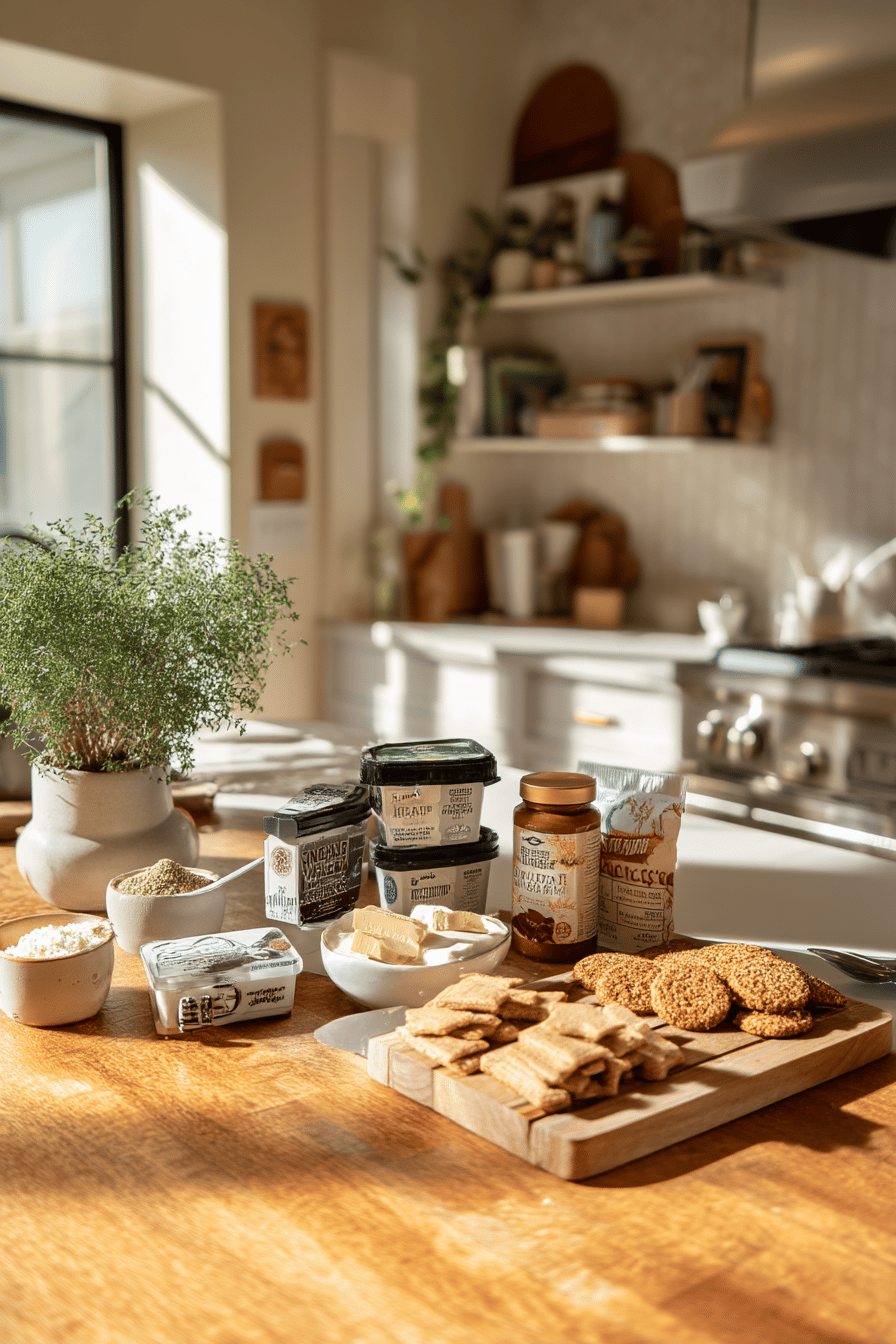
Dietary Substitutions to Customize Your Biscoff Cheesecake
Adapting the biscoff cheesecake for different dietary needs is simple with various ingredient substitutions:
- Vegan Options: Use plant-based cream cheese and substitutes like coconut or cashew cream instead of dairy cream. Replace regular butter with vegan butter or coconut oil. For eggs, consider aquafaba or commercial egg replacers to maintain structure and moisture.
- Gluten-Free Version: Substitute regular biscoff cookies with certified gluten-free spiced cookies or gluten-free biscoff cookie crumbs. Confirm all additives are gluten-free certified.
- Low-Sugar or Low-Calorie: Swap brown and granulated sugars with natural sweeteners like stevia, erythritol, or monk fruit. Use light cream cheese versions and reduce or omit heavy cream for a lighter texture.
- Nut-Free Adaptations: Ensure biscoff cookies and spreads are nut-free and avoid toppings containing nuts, using seed-based garnishes instead.
These substitutions keep the rich biscoff flavor and creamy consistency intact while catering to various dietary restrictions and preferences.
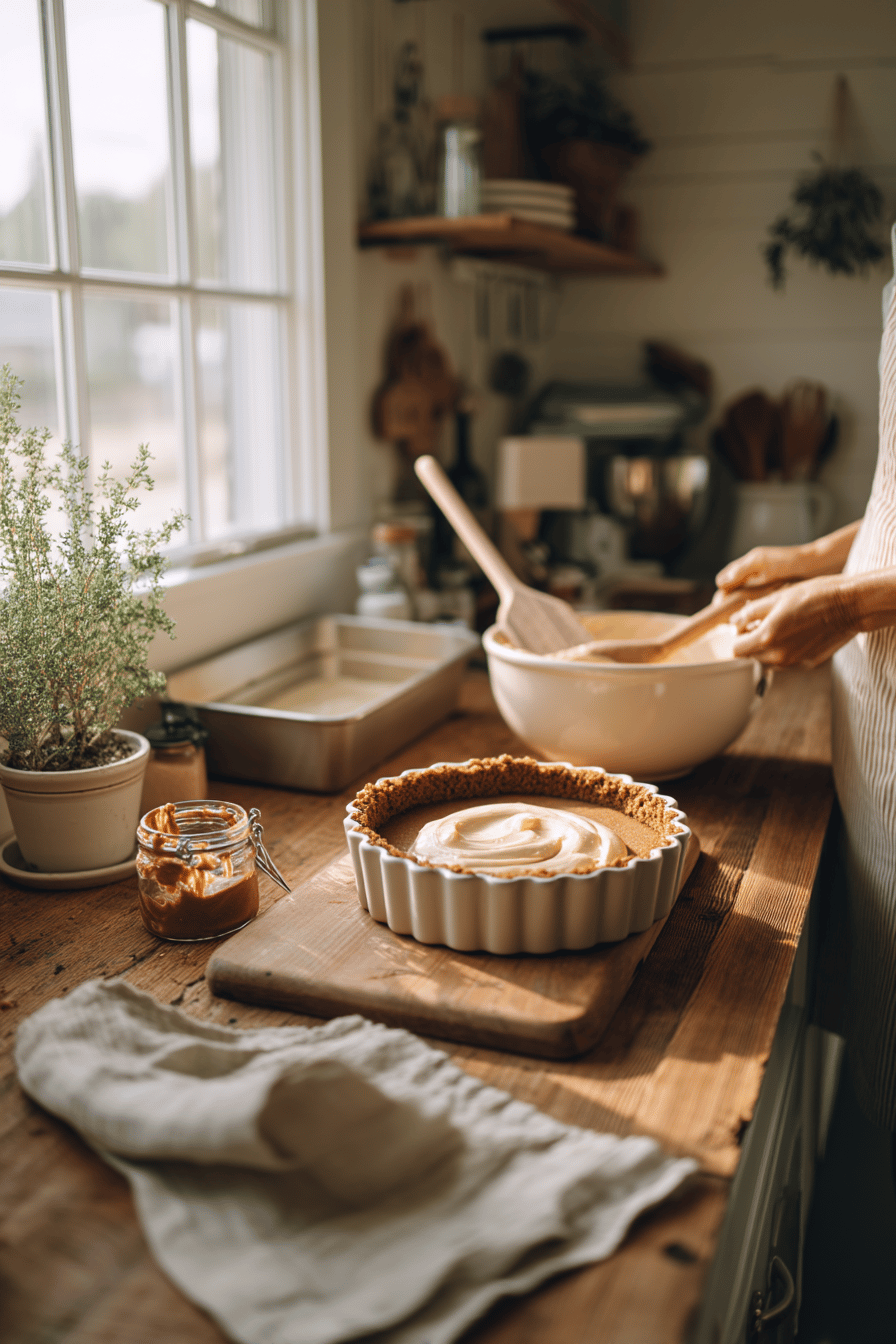
How to Prepare the Perfect Biscoff Cheesecake: Step-by-Step Guide
- Prepare the crust: Preheat your oven to 325°F (163°C). Crush 250 grams of biscoff cookies into fine crumbs using a food processor or by hand. Melt 75 grams of unsalted butter (or vegan butter) and combine with the crumbs. Press firmly into the bottom of an 8-inch deep or 9-inch springform pan. Bake for 10 minutes, then set aside to cool completely. For no-bake versions, skip baking and chill crust in the refrigerator.
- Make the cheesecake batter: Beat 907 grams of softened cream cheese on medium speed until creamy (about 3 minutes). Gradually add 1 cup brown sugar and 1/4 cup granulated sugar, beating for 2-3 more minutes and scraping the bowl as needed. Incorporate 1/2 cup sour cream and 1 cup biscoff cookie butter spread, followed by 1 tablespoon vanilla extract and 1/4 teaspoon salt. Add 4 large eggs one at a time, mixing just until combined after each addition to avoid overmixing. For no-bake versions, whip 300 ml double cream until thick and gently fold into the cream cheese mixture.
- Bake the cheesecake: Pour the batter over the cooled crust. Grease the springform pan sides to prevent sticking. Wrap the pan’s bottom tightly with foil to prevent water seepage. Place the pan in a roasting pan filled with hot water (water bath) and bake at 325°F (163°C) for 60-70 minutes. The cheesecake is done when edges are set and the center slightly jiggles when shaken gently. Turn off the oven and leave the cheesecake inside with the door closed for 1 hour to prevent cracks.
- Cool and chill: Remove from oven and unwrap foil. Refrigerate the cheesecake for at least 6 hours or overnight to set completely. For no-bake variations, refrigerate the filled crust for 3-4 hours or overnight.
- Decorate: Melt 1/2 cup of biscoff spread until pourable and drizzle over the chilled cheesecake. Sprinkle with 1/4 cup biscoff cookie crumbs and add crushed biscoff cookies if desired. Optionally, top with whipped cream or vegan alternatives before serving.
Following these clear steps ensures your biscoff cheesecake develops its signature creamy texture paired with the rich, spiced flavor of biscoff. For helpful baking techniques, consider resources like How to Make a Water Bath for Cheesecake and Tips for Baking the Perfect Cheesecake.
Advanced Tips and Variations
Enhance your biscoff cheesecake experience with these expert tips and creative variations for perfect results every time.
- Layer With Biscoff Spread: Add a generous layer of biscoff cookie butter between the crust and cheesecake filling to intensify the signature flavor.
- Use Premium Cream Cheese: High-quality cream cheese ensures a richer, smoother batter and better texture.
- Chill the Batter: Refrigerating the mixture before baking can help improve the cheesecake’s density and creaminess.
- Spice It Up: Introduce subtle cinnamon or nutmeg to complement the caramel spice in the biscoff cookies.
- Vegan Option: Blend silken tofu with vegan cream cheese for a dense, creamy texture when making vegan biscoff cheesecake.
- Decorative Toppings: Experiment with caramel drizzle, fresh fruit, or melted chocolate for added depth and visual appeal.
- Mini Cheesecakes: Use silicone molds or muffin tins for individual portions; adjust crust and bake times accordingly.
- Room Temperature Ingredients: Using room temperature components helps achieve smooth mixes and prevents lumps.
- Avoid Overbaking: Remove the cheesecake when the edges are set but the center slightly jiggles to prevent cracking and dryness.
How to Store Biscoff Cheesecake: Best Practices
Proper storage preserves the creamy texture and caramel-spiced flavor of your biscoff cheesecake:
- Refrigeration: Store the cheesecake in an airtight container or tightly wrapped with plastic wrap to prevent drying and absorption of odors. It will stay fresh for up to five days in the refrigerator.
- Freezing: For longer storage, wrap the cheesecake securely in plastic wrap and then aluminum foil to prevent freezer burn. Freeze for up to two months.
- Thawing: Thaw frozen cheesecake overnight in the refrigerator before serving to maintain optimal texture and flavor.
- Reheating: Generally avoid reheating as it can affect texture; if desired, bring to room temperature before serving none warm.
Following these methods maintains the cheesecake’s moistness and rich biscoff flavor, allowing on-demand enjoyment.
Nutritional Value of Biscoff Cheesecake
| Nutrient | Approximate Amount per Slice (12 servings) |
|---|---|
| Calories | 350-445 kcal |
| Carbohydrates | 20-26 g |
| Protein | 4-5 g |
| Fat | 20-38 g |
The calorie range varies depending on whether you prepare a baked or no-bake version. Fat content mainly arises from cream cheese, butter, and biscoff spread. Carbohydrates come primarily from sugars and cookies. Selecting vegan or lower-fat alternatives can reduce calories and fat while maintaining flavor. Moderate protein content comes from the dairy components.
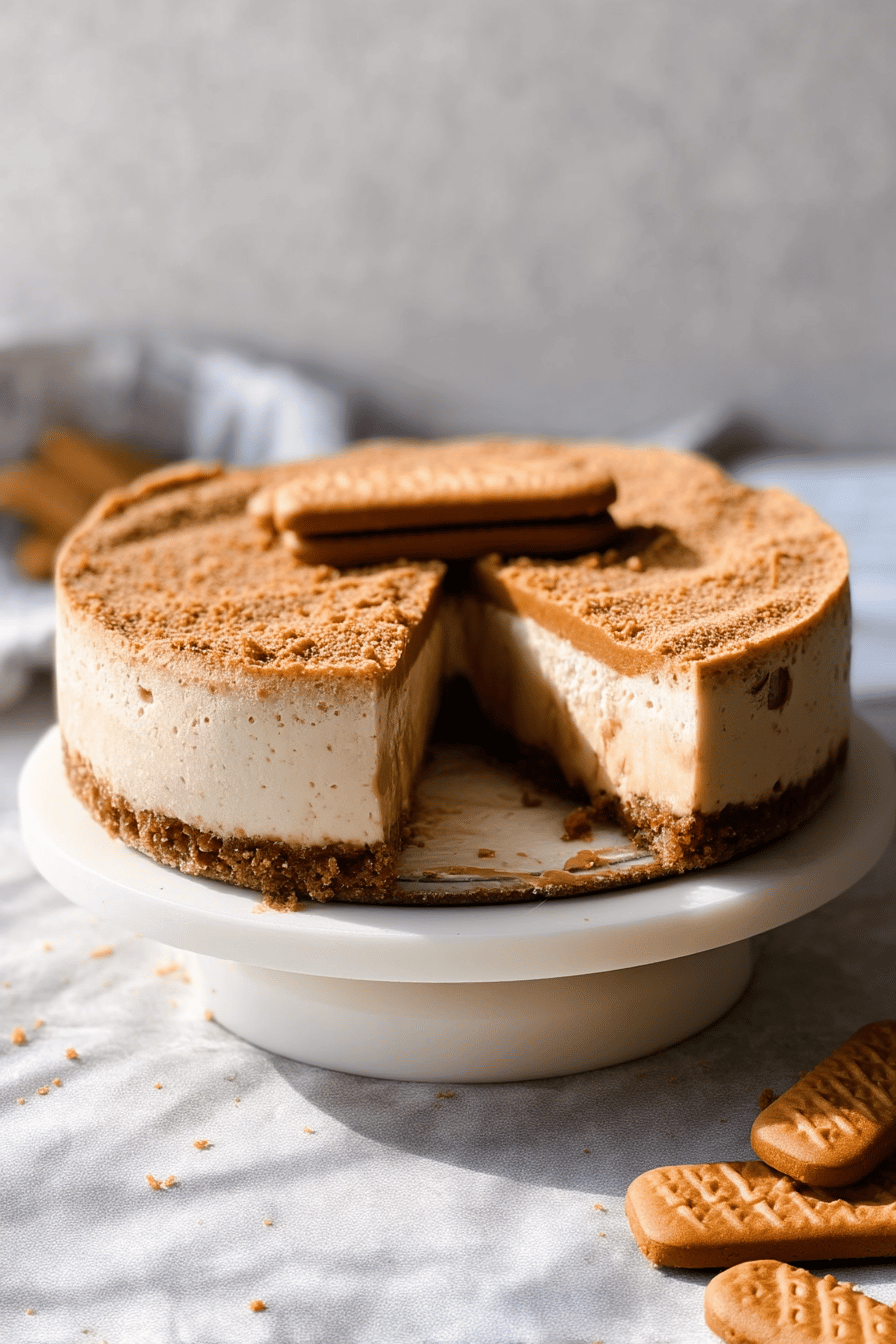
FAQs: Frequently Asked Questions About Biscoff Cheesecake
Can I make Biscoff cheesecake without eggs?
Yes, you can make a Biscoff cheesecake without eggs by choosing a no-bake recipe version. Since traditional baked cheesecakes require eggs to set the filling, a no-bake alternative uses gelatin or refrigeration to firm up the cheesecake. This is a great option for those with egg allergies or who prefer an egg-free dessert. Be sure to follow a recipe specifically designed without eggs to achieve the right texture.
How should I know when my Biscoff cheesecake is fully baked?
The cheesecake is done when the edges are set and the center still has a slight wobble when you gently shake the pan. The filling should not look liquid but shouldn’t be completely firm either. Overbaking can cause cracks, so avoid baking until fully solid. After baking, the cheesecake will continue to firm up as it cools in the fridge.
Can I substitute sour cream with Greek yogurt in Biscoff cheesecake?
Yes, Greek yogurt is a good substitute for sour cream and offers a similar creamy texture with slightly less fat. Use an equal amount of Greek yogurt in place of sour cream to maintain the cheesecake’s rich taste. This swap also adds a subtle tang and can make the cheesecake a bit lighter.
What is the best way to store leftover Biscoff cheesecake, and how long does it last?
Store leftover Biscoff cheesecake in an airtight container in the refrigerator where it will stay fresh for up to 4 to 5 days. For longer storage, you can freeze the cheesecake—wrap it tightly in plastic wrap and foil—where it keeps well for up to 2 months. Thaw frozen cheesecake in the fridge overnight before serving.
Can I make mini Biscoff cheesecakes, and what should I change in the baking process?
Yes, mini Biscoff cheesecakes are possible and perfect for individual servings. Use muffin tins lined with cupcake liners, press about 1 tablespoon of crust into each cup, and pre-bake the crust for 5 minutes. Fill with cheesecake batter and bake for 18-22 minutes without a water bath. Chill the mini cheesecakes for at least 4 hours before adding any toppings.
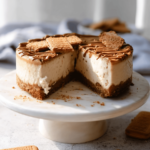
Biscoff Cheesecake Recipe with Only 5 Ingredients – Creamy, Easy, and Crowd-Pleasing
- Total Time: 4 hours 20 minutes to 8 hours 40 minutes
- Yield: 12 servings 1x
- Diet: Vegetarian
Description
🍰 Enjoy a creamy, luscious Biscoff Cheesecake with a rich flavor that’s both satisfying and simple.
✨ Perfect for gatherings or special occasions, this dessert will impress any crowd with minimal effort.
Ingredients
250 grams Biscoff cookies
75 grams unsalted butter, melted
907 grams cream cheese, softened
1 cup (200 grams) brown sugar
1/4 cup (50 grams) granulated sugar
1/2 cup (120 grams) sour cream
1 cup (240 grams) Biscoff cookie butter
1 tablespoon vanilla extract
1/4 teaspoon salt
4 large eggs, room temperature
1/2 cup Biscoff spread, melted
1/4 cup Biscoff cookie crumbs
Additional crushed cookies for garnish (optional)
Instructions
1. Preheat the oven to 325°F (163°C). Crush Biscoff cookies into fine crumbs.
2. Combine the crumbs with melted butter and press into the bottom of a springform pan.
3. Bake the crust for 10 minutes, then allow it to cool completely.
4. Beat cream cheese until creamy. Add sugars and beat until smooth. Mix in sour cream and Biscoff spread.
5. Add vanilla extract and salt. Incorporate eggs one at a time, mixing gently.
6. Pour batter over the cooled crust. Wrap pan in foil and place in a water bath.
7. Bake for 60 to 70 minutes. Turn off the oven and let the cheesecake sit for 1 hour.
8. Refrigerate for at least 6 hours or overnight.
9. Drizzle melted Biscoff over the chilled cheesecake and garnish with extra crumbs.
Notes
🧈 Use room temperature ingredients to ensure a smooth batter.
🥚 Avoid overmixing the eggs to prevent cracks.
❄️ Wrap in foil tightly during the water bath to prevent water leakage.
- Prep Time: 20–40 minutes
- Chill time: 6 hours or overnight
- Cook Time: 60–70 minutes
- Category: Dessert
- Method: Baking
- Cuisine: American
Nutrition
- Serving Size: 1 slice
- Calories: 350-445
- Sugar: 20-26g
- Sodium: 200mg
- Fat: 20-38g
- Carbohydrates: 20-26g
- Protein: 4-5g
Keywords: Biscoff Cheesecake, Creamy Cheesecake, Easy Dessert, 5 Ingredient Cheesecake

